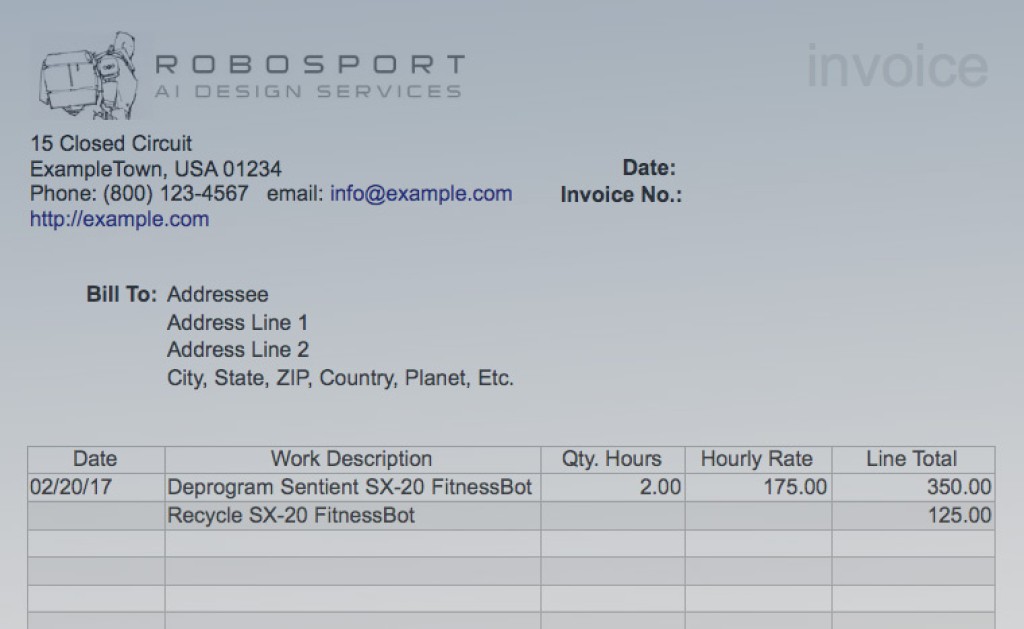
A Marc Carson Web Download
Simple Invoice Template for LibreOffice

Download Now: Simple Invoice Template.ods
Here is a simple template that should be good enough for a small business or freelancer.
It works like this: Go tell someone how you can help them, tell them what it will cost, get their approval, do the work, then send them this invoice with your numbers filled in. There, I just helped you make money!
Are you new at this? You may wish to read my article, The Do’s and Don’ts of Invoicing a Client for the First Time.
Here are some general invoicing tips:
- “No surprises” is a good rule for client relationships. If you expect to be paid tomorrow, don’t just send an invoice demanding payment tomorrow. You should agree upon those terms before you begin work. Many clients will assume that net-30 payment (payment issued within 30 days) is acceptable, or will make it their policy. To me, net-30 is ridiculous and absolutely worth negotiating down before work begins. So policies can always be changed, no matter what anyone says, but it’s up to you to communicate your needs.
- You can make your own billing policies. For example, if clients who generally pay you less than $100 tend to pay late or not at all, you can make it your policy that projects under $100 must be paid in full before work begins. I’ve never seen anyone balk about this sort of thing, and it generally improves worker morale. :-) The key is, again, communication with the client.
- Many freelancers put themselves out of business because they don’t do enough pricing research. Read books, look at competitors, and continue doing that periodically. Your clients do not want you to put yourself out of business with lemonade stand pricing, believe me.
- Try to look at your competition as colleagues and potential friends, rather than enemies. Meet them, befriend them if possible, and often you’ll find that they are a better client than many of your actual clients. If you can’t be friends, at least don’t be afraid of them, and remember to play to your strengths rather than trying to match up with competitors all the time.
- If you tend to market yourself by undercutting your competition, remember that “pricing is positioning.” Your clients may look at you as a low-end, or under-educated vendor if your prices are low-end, which can turn into an exploitative situation very fast. Educated clients tend to look at higher prices as an indication of quality. This has been reinforced by thousands of years of human marketing behavior. And I should mention that your work still has to be pretty good if you are demanding upmarket fees.
- I left out a bunch of clutter fields like “discount”…that one is overused by new freelancers / contractors. People take you more seriously if you charge normal rates or give them a range of costs to pick from ahead of time, like “good, better, or best”. Letting your clients decide what they can afford (rather than trying to read their minds) is always a good idea.
- If you do some significant free work for a relative or a friend on a “favor” basis (and please don’t pressure yourself into this), you may want to send an invoice to them anyway. Write down everything you did, note what the cost would be for a normal client, add some “discount” text, and enter a 100% discount. This may be helpful for them to keep as a record, and may prevent the devaluation of your work when they send you referrals in the future. In my experience, it’s a really dumb idea to do free work for someone, and then never communicate to them what exactly the free work was.
License: Free, GPL. Robot Illustration by Yours Truly.
Even More Templates I Made
Simple Invoice Template for LibreOffice
Simple LibreOffice Fax Coversheet Template
Free LibreOffice Template: Flowchart
Free LibreOffice Template: Flyer/Brochure
« Previous: Simple LibreOffice Fax Coversheet Template


